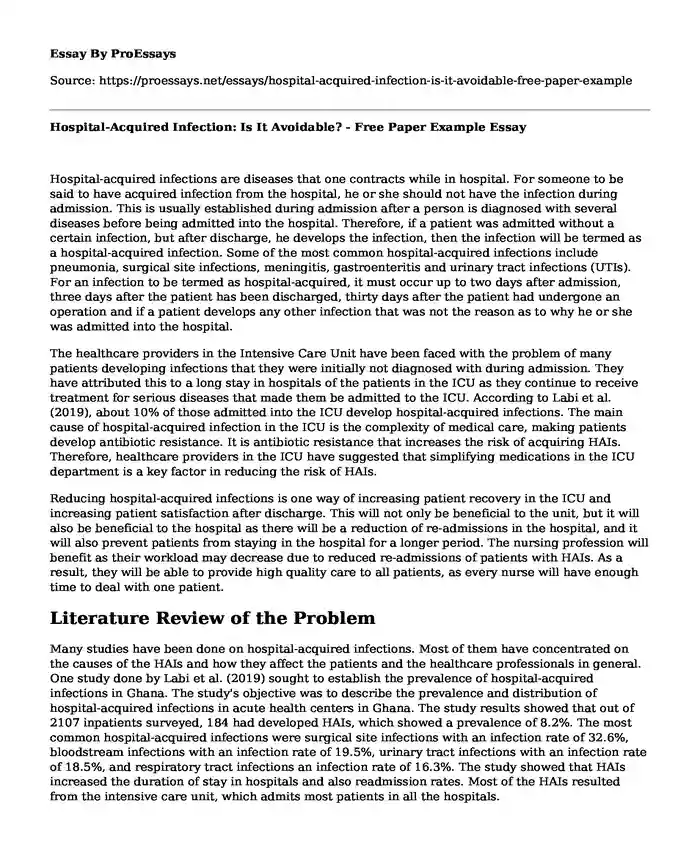Hospital-acquired infections are diseases that one contracts while in hospital. For someone to be said to have acquired infection from the hospital, he or she should not have the infection during admission. This is usually established during admission after a person is diagnosed with several diseases before being admitted into the hospital. Therefore, if a patient was admitted without a certain infection, but after discharge, he develops the infection, then the infection will be termed as a hospital-acquired infection. Some of the most common hospital-acquired infections include pneumonia, surgical site infections, meningitis, gastroenteritis and urinary tract infections (UTIs). For an infection to be termed as hospital-acquired, it must occur up to two days after admission, three days after the patient has been discharged, thirty days after the patient had undergone an operation and if a patient develops any other infection that was not the reason as to why he or she was admitted into the hospital.
The healthcare providers in the Intensive Care Unit have been faced with the problem of many patients developing infections that they were initially not diagnosed with during admission. They have attributed this to a long stay in hospitals of the patients in the ICU as they continue to receive treatment for serious diseases that made them be admitted to the ICU. According to Labi et al. (2019), about 10% of those admitted into the ICU develop hospital-acquired infections. The main cause of hospital-acquired infection in the ICU is the complexity of medical care, making patients develop antibiotic resistance. It is antibiotic resistance that increases the risk of acquiring HAIs. Therefore, healthcare providers in the ICU have suggested that simplifying medications in the ICU department is a key factor in reducing the risk of HAIs.
Reducing hospital-acquired infections is one way of increasing patient recovery in the ICU and increasing patient satisfaction after discharge. This will not only be beneficial to the unit, but it will also be beneficial to the hospital as there will be a reduction of re-admissions in the hospital, and it will also prevent patients from staying in the hospital for a longer period. The nursing profession will benefit as their workload may decrease due to reduced re-admissions of patients with HAIs. As a result, they will be able to provide high quality care to all patients, as every nurse will have enough time to deal with one patient.
Literature Review of the Problem
Many studies have been done on hospital-acquired infections. Most of them have concentrated on the causes of the HAIs and how they affect the patients and the healthcare professionals in general. One study done by Labi et al. (2019) sought to establish the prevalence of hospital-acquired infections in Ghana. The study's objective was to describe the prevalence and distribution of hospital-acquired infections in acute health centers in Ghana. The study results showed that out of 2107 inpatients surveyed, 184 had developed HAIs, which showed a prevalence of 8.2%. The most common hospital-acquired infections were surgical site infections with an infection rate of 32.6%, bloodstream infections with an infection rate of 19.5%, urinary tract infections with an infection rate of 18.5%, and respiratory tract infections an infection rate of 16.3%. The study showed that HAIs increased the duration of stay in hospitals and also readmission rates. Most of the HAIs resulted from the intensive care unit, which admits most patients in all the hospitals.
Another study was done by Eckenrode et al. (2014) to establish the relationship between sex, age and HAIs rates of the inpatients. The study's purpose was to show whether age and sex may affect the risk of developing hospital-acquired infections. The research used a sample of 85,461 patients of different ages and gender. The study results showed that younger women had a higher risk of contracting HAIs than young males. However, there was no significant higher risk of developing HAIs for the elderly. Among those patients suffering from cardiovascular disease, women were more affected by HAIs, but there was no significant difference when it came to pneumonia patients. Among the surgical patients, both men and women had a higher risk of developing HIAs regardless of age. The authors concluded that there was no higher risk of developing HAIs with increased age for pneumonia, major surgery, and acute cardiovascular disease. The relationship between sex and the rate of developing HAIs varied depending on one's underlying conditions.
References
Eckenrode, S., Bakullari, A., Metersky, M. L., Wang, Y., Pandolfi, M. M., Galusha, D. & Eldridge, N. (2014). The association between age, sex, and hospital-acquired infection rates: results from the 2009-2011 National Medicare Patient Safety Monitoring System. Infection Control & Hospital Epidemiology, 35(S3), S3-S9. https://www.cambridge.org/core/journals/infection-control-and-hospital-epidemiology/article/association-between-age-sex-and-hospitalacquired-infection-rates-results-from-the-20092011-national-medicare-patient-safety-monitoring-system/E3D29ED1D4D3C1FEBE2192EBA5C2DE4F.
Labi, A. K., Obeng-Nkrumah, N., Owusu, E., Bjerrum, S., Bediako-Bowan, A Sunkwa-Mills, G. & Debrah, S. (2019). Multi-center point-prevalence survey of hospital-acquired infections in Ghana. Journal of Hospital Infection, 101(1), 60-68. https://www.sciencedirect.com/science/article/pii/S0195670118302573
Cite this page
Hospital-Acquired Infection: Is It Avoidable? - Free Paper Example. (2023, Oct 25). Retrieved from https://proessays.net/essays/hospital-acquired-infection-is-it-avoidable-free-paper-example
If you are the original author of this essay and no longer wish to have it published on the ProEssays website, please click below to request its removal:
- Article Analysis Example: Competition Would Be the Best Solution to Rising Drug Prices
- My Goals in the Field of Nursing Essay
- Anti-Smoking Campaign Advert Analysis
- Essay Example on Telehealth: Quality Healthcare Delivery via ICT Systems
- Essay Sample on Clinician Nurses: Team Care for Optimal Clinical Outcomes
- Morality of Abortion: Thomson vs Marquis - Essay Sample
- Report on Exploring Pharmacology: Patient Outcomes, Safety, Community Impact, and Inequities in Access







